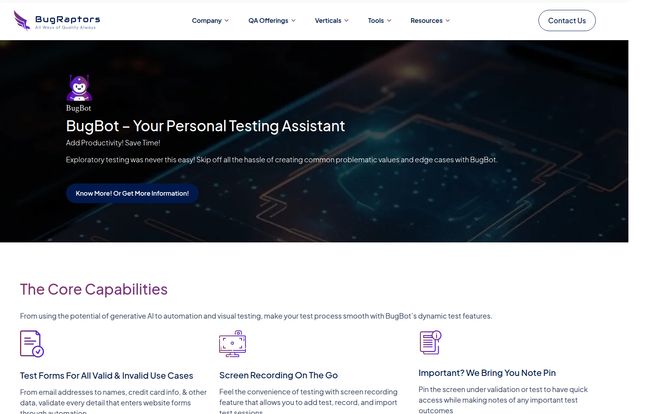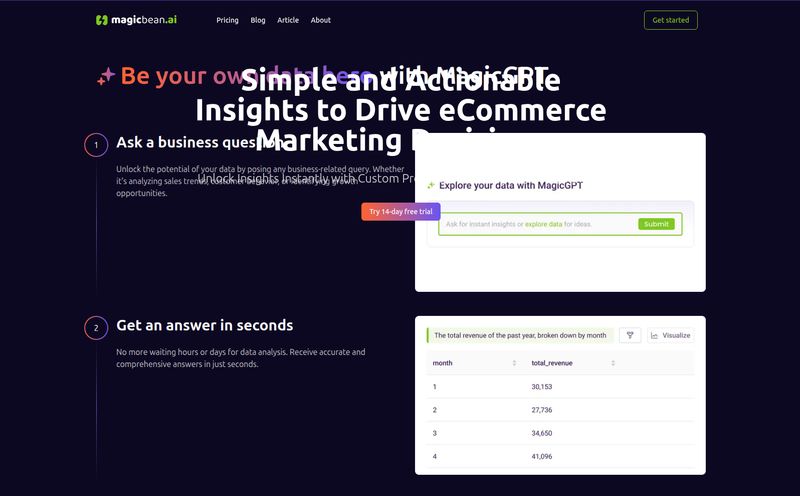We've all been there. It's 4:45 PM on a Friday, the big release is supposed to go live, and you're stuck in the endless, soul-crushing loop of regression testing. Clicking the same buttons, filling out the same forms, and praying you don't miss that one tiny, catastrophic bug that'll bring the whole system down over the weekend. Manual testing can feel like trying to find a specific needle in a giant, ever-changing haystack... of needles. It’s tedious, it's prone to human error, and honestly, who has time for that?
For years, the promise of automation has been our guiding star. But setting up frameworks is complex, scripts are brittle, and maintaining them can become a full-time job in itself. So when I see a tool pop up that throws "AI" into the mix, my inner cynic raises an eyebrow, but the overworked QA professional in me leans in a little closer. Today, we're looking at one such tool: BugBot from the folks over at BugRaptors.
They call it a "Personal Testing Assistant." A bold claim. But is it just marketing fluff, or is there some real fire behind that smoke? Let's find out.

Visit BugBot
So, What Exactly is BugBot?
At its core, BugBot is an intelligent automation testing tool. Think of it less like a dumb script-runner and more like a tireless QA intern who never sleeps, never complains, and runs on pure data. It’s designed by BugRaptors, a pretty established name in the software testing space, to speed up the whole testing cycle. Instead of you manually poking around an application, BugBot uses artificial intelligence to automate finding, validating, and reporting issues.
It’s built to handle things like functional testing, regression checks, and even the visual stuff. The whole idea is to take the 'robot' out of the human and let the actual robot do the repetitive work, freeing up your team's brainpower for more complex, exploratory testing. You know, the fun stuff.
The Core Features That Actually Matter
A feature list is just a list until you see how it solves a real problem. I dug through their offerings, and a few things genuinely stood out to me as being more than just bells and whistles.
AI-Powered Visual Testing
This is a big one. Anyone who's tried to automate visual regression testing knows the pain. A browser updates, a font renders a pixel differently, and suddenly your entire test suite is a sea of red. It's incredibly brittle. BugBot claims its AI can intelligently tell the difference between a real visual bug (like a button overlapping text) and a minor, insignificant rendering change. If it works as advertised, this could save hours of sifting through false positives. It’s about identifying actual visual discrepancies on the fly without the fragility of old-school pixel-to-pixel comparison.
Smarter Form and Data Validation
Testing forms is the worst. Valid inputs, invalid inputs, edge cases, special characters... it's a grind. BugBot comes to the table with a library of pre-defined test data and the ability to auto-generate what it needs. It can intelligently fill out forms to check for both valid and invalid use cases, looking for those pesky format errors or submission fails. This automation of data-driven testing is a huge time-saver, especially for complex applications with dozens of user input fields.
Session Recording and the 'Note Pin'
Okay, this is pretty cool. BugBot records test sessions, capturing everything from user interactions to network logs. When a bug appears, you don’t have to write down a 12-step novel on how to reproduce it. You just send the recording. This bridges the gap between QA and developers so beautifully. But the feature I really love is the Note Pin. During a recorded session, you can drop a pin and add a contextual note. It’s such a simple, human-centric touch. It’s like being able to put a sticky note right onto the application at the exact moment you spotted something weird. I've always felt that the quality of a bug report is half the battle, and this makes it practically foolproof.
The Real-World Impact: Why Should You Care?
So, what does all this mean for your team and your bottom line? It's not just about fancy tech; it's about tangible outcomes.
The most obvious benefit is time savings. By automating the repetitive grind of regression and functional testing, your team gets more time back. Time to focus on new features, perform more creative exploratory testing, or maybe, just maybe, leave work on time. The promise of faster execution means you can integrate this into a CI/CD pipeline and get feedback much earlier in the development process. Faster feedback loops lead to faster delivery and, ultimately, a better product hitting the market sooner.
Then there's the reduction in manual intervention. This isn't just about speed; it's about morale. Repetitive, mind-numbing work leads to burnout and mistakes. By handing that off to BugBot, you're not replacing your QA team; you're elevating them. You're turning them from manual checkers into quality strategists. And let's not forget accuracy—within its specified environments, a well-configured automation tool is simply more consistent than a human who's on their fourth cup of coffee.
Let's Be Real: The Potential Downsides
No tool is perfect, and it’s important to go in with eyes wide open. Based on the information available, there are a few things to consider.
- The Subscription Catch: Access to those juicy, pre-built, tailored test data sets might require a subscription. This isn't surprising, but it's a cost factor to be aware of.
- Platform Limitations: As of now, it seems the primary support is for front-end and back-end technologies running on Chrome. If your user base is heavy on Firefox, Safari, or Edge, this could be a significant limitation. I'd expect them to expand this, but it's a critical question to ask.
- The AI Caveat: At the end of the day, the tool's effectiveness hinges on the quality of its AI and automation. 'Intelligent' is a spectrum. The tool will only be as good as the algorithms powering it and how well they adapt to your specific application.
These aren't necessarily deal-breakers, but they are crucial points for any proof-of-concept you might run.
What's the Price Tag on This AI Assistant?
Here's the million-dollar question. And the answer is... you'll have to ask them. Like a lot of enterprise-grade B2B software, BugRaptors doesn't list BugBot's pricing on their website. You're prompted to fill out a form to "Know More Or Get Information." This usually means they have a tiered pricing model based on team size, usage, or specific feature sets. It's a classic "contact sales" situation, which makes sense for a tool that might require some level of onboarding and integration support.
Frequently Asked Questions About BugBot
1. What exactly is BugBot?
BugBot is an AI-enhanced automation testing tool created by BugRaptors. It's designed to automate various testing processes like functional, regression, and visual testing to help QA teams find and report bugs faster and more efficiently.
2. Does BugBot support mobile app testing?
The documentation focuses heavily on web applications, particularly on the Chrome browser. While BugRaptors as a company offers mobile testing services, you would need to confirm with their team directly about BugBot's current capabilities for native iOS or Android testing.
3. How is the AI in BugBot different from a standard script?
Unlike a standard, rigid script that fails if a button's ID changes, the AI in BugBot aims to be more resilient. For example, in visual testing, it can differentiate between a minor, acceptable rendering change and a true UI bug. It also assists in intelligently generating test data for forms.
4. Who is the ideal user for BugBot?
BugBot seems best suited for agile software development teams, dedicated QA departments, and organizations with a mature CI/CD pipeline who want to accelerate their testing cycles and reduce the burden of manual regression testing.
5. Is there a free trial for BugBot?
There is no public free trial mentioned. To evaluate the tool, you'll likely need to contact the BugRaptors sales team to request a demo or a proof-of-concept trial for your organization.
My Final Thoughts on BugBot
So, is BugBot the revolution in QA we've all been hoping for? It's a strong contender in a growing field. It’s not magic; it’s a tool. And like any good tool, its value will come from how you use it. I'm genuinely intrigued by the focus on human-centric features like the Note Pin alongside the heavy-lifting AI. It shows an understanding of the actual day-to-day workflow of a QA professional.
For teams drowning in manual regression checks and looking for a way to claw back some sanity, BugBot is definitely worth investigating. The current limitation to Chrome is a point of caution, but for many, that's not a deal-breaker. If they can deliver on the promise of truly intelligent visual testing and robust test automation, this little bot could become a very valuable member of your team.
Have you used BugBot or a similar AI testing tool? Drop a comment below. I'd love to hear about your experiences in the trenches.
Reference and Sources
- BugRaptors Official Website: https://www.bugraptors.com/
- BugBot Product Page: https://www.bugraptors.com/bugbot/



